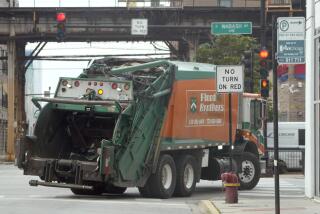Mirrors reflect safety debate
- Share via
Rearview mirrors are supposed to provide drivers with exactly what their name suggests: a view of the road behind them.
But many safety experts disagree on whether it’s better to rely on mirrors to check for traffic when making a lane change, or simply to turn your head and look over your shoulder.
Some experts warn motorists to never take their eyes off the road, saying that with proper adjustment, mirrors should provide the required visibility needed to make lane changes and other maneuvers.
But other authorities insist that motorists take a big risk by relying on their side and rearview mirrors and say that every lane change must be accompanied by both a mirror check and a swivel of the head.
Unfortunately, federal standards for mirrors have not changed for 20 years, and vehicles vary greatly in how much rear visibility their mirrors provide.
As for the California Department of Motor Vehicles, the agency issued a handbook that advises drivers to always turn their heads before making a lane change. When I called Sacramento to ask the DMV where that advice came from, they referred me to the California Highway Patrol, which vouched for the advice.
“That’s the way our patrol officers are taught to drive,” said CHP spokeswoman Anne DaVigo. “They do a mirror check, a head check and a mirror check. The best drivers have that assurance.”
But such advice contradicts basic safety tenets, said Gerald Donaldson, research vice president of Advocates for Highway Safety. “Head checks are one of the most dangerous things you can do,” he said. “If you use a mirror correctly, you can still have forward vision.”
Engineers at the National Highway Traffic Safety Administration attempt to avoid this dispute, but say in their personal driving they usually rely on mirrors for 90% of their lane changes and do not look over their shoulder.
One point of debate is how to properly adjust the side mirrors. Most drivers adjust the mirrors so that a portion of their vehicle is in view as a reference point. But engineers, and experts such as Donaldson, say that is completely incorrect, because it creates a blind spot that obscures cars in the area immediately behind the driver’s peripheral vision. They say a better idea is to position the side-view mirrors so that they point away from the car and provide a different view of the rear than is provided by the interior rearview mirror. Engineers do not believe it is possible to eliminate blind spots completely, but they can be reduced. Also, properly adjusted mirrors often will show only a portion of the front or rear of another vehicle in an adjacent lane, and that might not be enough of a visual cue to safely make a lane change.
Most manufacturers equip vehicles with convex mirrors on the passenger side, but by law they must provide a flat mirror on the driver’s side.
The widespread use of aftermarket convex mirrors for the driver’s side is one indication that many motorists desire a better field of view and reject the idea of turning their heads every time they change lanes.
Another important issue is whether a rearview mirror can provide adequate visibility of the adjacent lane and a view of drivers two lanes over who may be trying to merge into your lane. This is one instance where a head check can provide a greater margin of safety.
Also, relying completely on mirrors while driving at night on a crowded, multi-lane freeway can be difficult, because the view they provide often is a jumble of bright headlights. Head checks can help provide assurance, but not everybody can make a quick head check. A relatively fit young driver can swivel his or her head in less than one second, but many people with back and neck problems do not have this kind of mobility. For them, mirrors are an essential part of driving.
Unfortunately, federal regulators have done little research on mirrors and their role in preventing accidents. As part of a current effort to rewrite mirror standards, these issues would get additional research and debate.
In the meantime, motorists are left to their own devices. Safety experts say drivers should use mirrors in the manner that makes them most comfortable. But it also can be helpful to try a new approach, such as positioning the mirrors so that they provide a wider angle of view of the road.
Ralph Vartabedian cannot answer mail personally but responds in this column to automotive questions of general interest. Please do not telephone. Write to Your Wheels, Business Section, Los Angeles Times, 202 W. 1st St., Los Angeles, CA 90012. E-mail: ralph.vartabedian@latimes.com.







